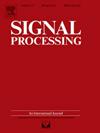FDA-MIMO radar detecting target embedded in mainlobe deceptive jamming plus Gaussian noise
IF 3.4
2区 工程技术
Q2 ENGINEERING, ELECTRICAL & ELECTRONIC
引用次数: 0
Abstract
In this paper, we address the challenge of detecting targets embedded in a mainlobe deceptive jamming environment, compounded by Gaussian noise, for the frequency diverse array multiple input multiple output (FDA-MIMO) radar. Unlike conventional MIMO and/or phased-array (PA) radar systems, FDA-MIMO radar leverages additional range information, presenting a promising avenue for mitigating mainlobe deception interference. Our work begins by establishing a waveform-orthogonal FDA-MIMO radar received signal model under Gaussian noise, which encompasses thermal noise, suppression interference, and clutter after secondary range dependence compensation. Subsequently, we formulate the problem of binary hypothesis signal detection in the presence of mainlobe deception interference and training data within a detection scenario. To address this detection problem, we propose two adaptive detectors based on the one-step and two-step general likelihood ratio test (GLRT) criteria, denoted as OGLRT and TGLRT, respectively. Numerical simulation results demonstrate that our proposed detectors exhibit the constant false alarm rate (CFAR) property against the noise covariance matrix. Moreover, the performance of our proposed methods surpasses that of existing subspace detectors, with OGLRT exhibiting the best detection performance. As the frequency offsets for FDA-MIMO radar decrease, the performance of all detectors gradually deteriorates until they no longer retain target detection capabilities. This observation implies that, in the mainlobe deception interference environment considered in this paper, MIMO radar loses its ability to detect targets.
FDA-MIMO雷达探测嵌入在主瓣欺骗性干扰加高斯噪声中的目标
本文针对多输入多输出(FDA-MIMO)雷达中嵌入在主瓣欺骗性干扰环境中的目标检测问题进行了研究。与传统的MIMO和/或相控阵(PA)雷达系统不同,FDA-MIMO雷达利用额外的距离信息,为减轻主瓣欺骗干扰提供了一条有前途的途径。本文首先建立了高斯噪声下的波形正交的FDA-MIMO雷达接收信号模型,该模型包含热噪声、抑制干扰和二次距离相关补偿后的杂波。随后,我们提出了在检测场景中存在主瓣欺骗干扰和训练数据的二值假设信号检测问题。为了解决这一检测问题,我们提出了两种基于一步和两步一般似然比检验(GLRT)标准的自适应检测器,分别称为OGLRT和TGLRT。数值仿真结果表明,该检测器对噪声协方差矩阵具有恒定虚警率(CFAR)特性。此外,我们提出的方法的性能优于现有的子空间检测器,其中OGLRT表现出最好的检测性能。随着FDA-MIMO雷达频率偏移量的减小,所有探测器的性能逐渐恶化,直到它们不再保持目标检测能力。由此可见,在本文所考虑的主瓣欺骗干扰环境下,MIMO雷达失去了探测目标的能力。
本文章由计算机程序翻译,如有差异,请以英文原文为准。
求助全文
约1分钟内获得全文
求助全文
来源期刊

Signal Processing
工程技术-工程:电子与电气
CiteScore
9.20
自引率
9.10%
发文量
309
审稿时长
41 days
期刊介绍:
Signal Processing incorporates all aspects of the theory and practice of signal processing. It features original research work, tutorial and review articles, and accounts of practical developments. It is intended for a rapid dissemination of knowledge and experience to engineers and scientists working in the research, development or practical application of signal processing.
Subject areas covered by the journal include: Signal Theory; Stochastic Processes; Detection and Estimation; Spectral Analysis; Filtering; Signal Processing Systems; Software Developments; Image Processing; Pattern Recognition; Optical Signal Processing; Digital Signal Processing; Multi-dimensional Signal Processing; Communication Signal Processing; Biomedical Signal Processing; Geophysical and Astrophysical Signal Processing; Earth Resources Signal Processing; Acoustic and Vibration Signal Processing; Data Processing; Remote Sensing; Signal Processing Technology; Radar Signal Processing; Sonar Signal Processing; Industrial Applications; New Applications.
 求助内容:
求助内容: 应助结果提醒方式:
应助结果提醒方式:


